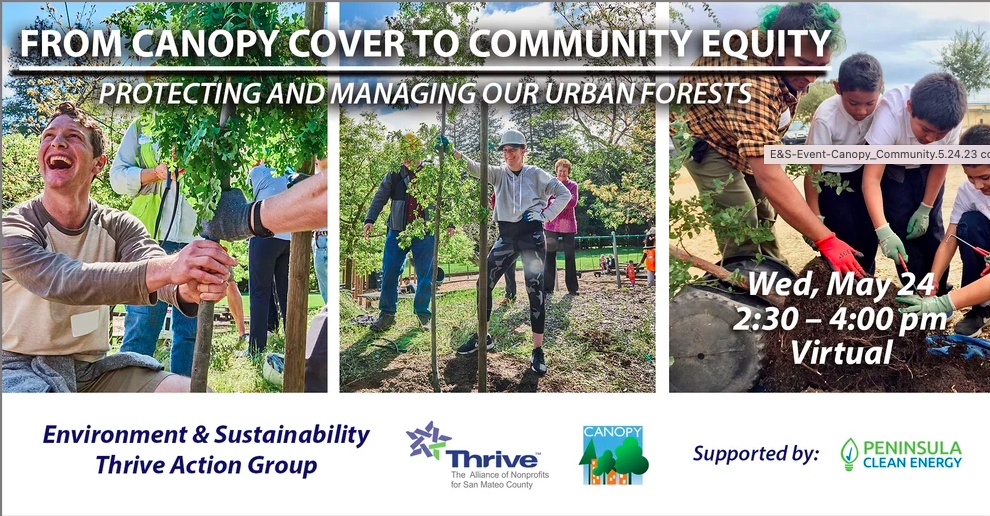Environment & Sustainability TAG- From Canopy Cover to community equity: Protecting and Managing our urban forest
Wednesday, May 24, 2:30 - 4:00 pm, Slides, Event Recording English and Spanish
MEETING RECAP
On Wednesday, May 24, Thrive hosted "From Canopy Cover to Community Equity: Protecting and Managing Our Urban Forest." This event brought together environmental enthusiasts, community activists, and experts in urban forestry to discuss the importance of safeguarding and effectively managing our urban forests.
Maya Briones, the Advocacy Associate at Canopy, kicked off the event by providing an overview of the critical role urban trees play in mitigating climate change, improving air quality, reducing urban heat islands, and enhancing the overall quality of life in cities.
Climate change exacerbated extreme heat, drought, storms, and fires, weakening trees and making them more susceptible to additional stressors. Lack of proper maintenance compounds these stressors and can ultimately lead to fallen trees, as demonstrated by the 2022-23 winter storms. Ultimately, this results in the loss of urban forests and natural forms of mitigation against extreme heat and air pollution.
Maya emphasized the importance of collaboration between local government, nonprofit organizations, and residents in building a resilient urban forest to mitigate climate change-related events. She noted, however, that each jurisdiction is politically, economically, and culturally unique and will have a different way of managing its urban forests. Older, smaller cities such as Palo Alto have integrated tree management into their planning for decades and have a dedicated department for managing their urban forest. Not all cities have the funding or staff to manage urban forests, nor policies that guarantee these programs. Unincorporated communities like North Fair Oaks rely on the County to develop and manage urban forests, yet the county government may not have the staff capacity or financial means to do so. Additionally, while some areas have urban forestry nonprofits to support this important work (OCF, Canopy, City Trees, FUF), many parts of the state do not have nonprofit support.
Developing an Urban Forest Master Plan (UFMP), a long-range plan that outlines specific goals and corresponding actions to preserve and manage tree canopy, is an effective approach to protecting and managing urban forests.. At the county level, a UFMP could involve various components, including conducting a comprehensive analysis of canopy cover data at the neighborhood level to represent disparities accurately. It would also include a maintenance plan for newly planted trees, gradually increasing canopy cover goals, establishing a robust approved species list, and implementing an equity plan that prioritizes addressing green gaps, such as the one observed in North Fair Oaks in San Mateo County. Data plays a crucial role in understanding community needs, as demonstrated by the UFMP for EPA. Using contracted data analysis experts such as SFEI and Bartlett Trees, maps were generated to illustrate the scarcity of trees in EPA compared to neighboring communities and its impact on community health. Such a UFMP ensures a systematic and long-term approach to enhancing tree canopy coverage and its associated benefits.
Some priority projects can have a significant impact, such as planting trees along sound walls. When trees are removed as a result of transportation projects and are not replaced, communities face increased risks of smog and pollutant exposure, noise pollution, and more. To address this, a requirement for tree replacement can be established between local and state governments prior to undertaking such projects. Local governments should advocate for their communities during federal projects and target streets with high pedestrian accidents and traffic. Collaboration among urban planners and relevant departments is crucial to achieving shared goals and addressing these issues effectively. Funding opportunities exist, as demonstrated by examples from other jurisdictions like the SCV Tree Alliance, which leverages existing resources, collects and analyzes data, and engages the community to expand and preserve urban tree canopy. The Alliance seeks sustainable funding mechanisms and aims to establish a permanent public funding source for urban forestry.
Following Canopy’s presentation, Walter Passmore, State Urban Forester at CAL Fire, provided an overview of the Green Schoolyards initiative, which has received 68 applications requesting a total of $355 million for projects on 413 campuses. However, there is only $117 million available for awards. Additionally, through the Inflation Reduction Act, $43.2 million in funding from the USDA Forest Service has been allocated to CAL FIRE's Urban and Community Forestry Program. The aim is to expand Arbor Day programs, including Tree City USA, Tree Campus USA, and Tree Line USA. A request for proposals to select sub-grants for these programs is expected before the end of the calendar year 2023. Walter provided several updates on policies in development, including a statewide strategic plan to increase canopy cover by 10% by 2035. The Legislature is currently considering various initiatives that address green schoolyards, climate bonds, pocket forests, grant administration, strategic plans for green highways, and California Climate Investments. Executive discussions have focused on securing base funding for Urban and Community Forestry. Additionally, the State Hazard Mitigation Plan has addressed the issue of extreme heat while emphasizing the importance of diversity, equity, and inclusion. Priority populations and disadvantaged communities are being prioritized within these policy updates.
Walter also shared a wealth of resources and tools to support urban forestry efforts during the event. He highlighted the Urban Forest Ecosystem Institute (UFEI) at California Polytechnic State University, which offers diverse programs and resources, including an urban forest assessment tool, a schoolyard forest system called the California Schoolyard Forest System (CSFS), a workforce development network, and urban wood network videos and training. Walter emphasized that the CSFS has been instrumental in planting over 1 million trees in California schools. At the same time, the workforce development network provides training and resources for individuals seeking employment in the urban forestry industry. He also mentioned the ongoing research project focused on growing more trees with limited water usage, utilizing techniques like drought-tolerant species, rainwater harvesting, and water-conserving tree-planting methods. Moreover, Walter mentioned the urban forestry camp designed for young people, enabling them to learn about trees, their benefits, and proper care. These resources collectively aim to enhance knowledge and management of urban forests, fostering healthy and sustainable environments for the benefit of both people and nature.
Maya and Walter called for action to uphold and enhance the protection and expansion of urban tree cover. They emphasized the importance of engaging with local government and urging collaboration among various sectors, community-based organizations (CBOs), county departments, boards of supervisors, and residents. Walter highlighted the need to promote responsible maintenance practices and encouraged reviewing and improving existing ordinances, and urged active involvement with local schools to increase urban tree cover (UTC) and enhance campus tree care. Both called for collaborative efforts and proactive engagement at the individual and community levels to safeguard and improve our urban forests.
Resources



